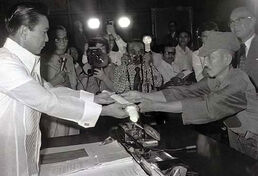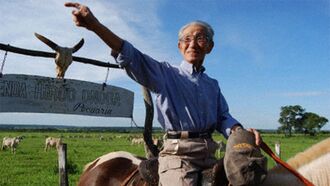Hirō "Hiroo" Onoda (小野田 寛郎, Onoda Hirō, 19 March 1922 – 16 January 2014) was an Imperial Japanese Army intelligence officer who fought in World War II and was a Japanese holdout who did not surrender at the war's end in August 1945. After the war ended Onoda spent 29 years hiding out in the Philippines until his former commander traveled from Japan to formally relieve him from duty by order of Emperor Shōwa in 1974. He held the rank of second lieutenant in the Imperial Japanese Army. He was the penultimate Japanese soldier to surrender, with Teruo Nakamura surrendering later in 1974.
Early Life
Onoda was born on 19 March 1922, in Kamekawa Village, Kaisō District, Wakayama Prefecture, Japan. His family line comes from a long line of samurai before the Meiji Restoration. When he was 17 years old, he went to work for the Tajima Yoko trading company in Wuhan, China. When he was 18, he was enlisted in the Imperial Japanese Army Infantry.
Military Service
Onoda trained as an intelligence officer in the commando class "Futamata" (二俣分校, futamata-bunkō) of the Nakano School. On 26 December 1944, he was sent to Lubang Island in the Philippines. He was ordered to do all he could to hamper enemy attacks on the island, including destroying the airstrip and the pier at the harbor. Onoda's orders also stated that under no circumstances was he to surrender or take his own life.
When he landed on the island, Onoda joined forces with a group of Japanese soldiers who had been sent there previously. The officers in the group outranked Onoda and prevented him from carrying out his assignment, which made it easier for United States and Philippine Commonwealth forces to take the island when they landed on 28 February 1945 as part of the American campaign to liberate the Philippines. Within a short time of the landing, all but Onoda and three other soldiers had either died or surrendered. Onoda, who had been promoted to lieutenant, ordered the men to take to the hills.
Time in Hiding
Guerilla warfare
Onoda and his men composed of Private Yūichi Akatsu, Corporal Shōichi Shimada and Private First Class Kinshichi Kozuka would wage a war of insurgency against the Americans and the Filipinos even after the Japanese surrender in September 1945. They resided in the mountains and forests of Lubang Island, where they looted nearby farms for food, sabotaged crops by burning them, and engaged in shootouts with the Philippine military, police, and armed villagers.
The first time they saw a leaflet announcing that Japan had surrendered was in October 1945; another cell had killed a cow and found a leaflet left behind by islanders which read: "The war ended on August 15. Come down from the mountains!" However, they distrusted the leaflet. They concluded that the leaflet was Allied propaganda, and also believed that they would not have been fired on if the war had indeed been over. Toward the end of 1945, leaflets were dropped by air with a surrender order printed on them from General Tomoyuki Yamashita of the Fourteenth Area Army. They had been in hiding for over a year, and this leaflet was the only evidence they had the war was over. Onoda's group studied the leaflet closely to determine whether it was genuine, and decided it was not.
One of the four, Yuichi Akatsu walked away from the others in September 1949 and surrendered to Filipino forces in 1950 after six months on his own. This seemed like a security problem to the others and they became even more cautious. In 1952 letters and family pictures were dropped from aircraft urging them to surrender, but the three soldiers concluded that this was a trick. Shimada was shot in the leg during a shoot-out with local fishermen in June 1953, after which Onoda nursed him back to health. On May 7, 1954, Shimada was killed by a shot fired by a search party looking for the men.
Somewhere in the early 1960s, Onoda and his companion Kozuka reportedly stole a working radio from a village. They received frequent news of world events occurring in the 1960s such as the 1964 Tokyo Olympics and the ongoing Vietnam War. Kozuka was killed by two shots fired by local police on October 19, 1972, when he and Onoda, as part of their guerrilla activities, were burning rice that had been collected by farmers. Onoda was now alone.
Discovery
On February 20, 1974, Onoda met a Japanese man, Norio Suzuki, who was traveling around the world, looking for "Lieutenant Onoda, a panda, and the Abominable Snowman, in that order". Suzuki found Onoda after four days of searching. Onoda described this moment in a 2010 interview to Brazilian media: "This hippie boy Suzuki came to the island to listen to the feelings of a Japanese soldier. Suzuki asked me why I would not come out..." Onoda and Suzuki became friends, but Onoda still refused to surrender, saying that he was waiting for orders from a superior officer. Suzuki also told that Onoda had became a media sensation back home in Japan. Suzuki returned to Japan with photographs of himself and Onoda as proof of their encounter, and the Japanese government located Onoda's commanding officer, Major Yoshimi Taniguchi, who had since become a bookseller. Taniguchi flew to Lubang accompanied by military personnel and journalists, and on 9 March 1974, he finally met with Onoda and fulfilled a promise he had made back in 1944: "Whatever happens, we'll come back for you". Taniguchi then issued Onoda the following orders:
| “ | 1. In accordance with the Imperial command, the Fourteenth Area Army has ceased all combat activity. 2. In accordance with military Headquarters Command No. A-2003, the Special Squadron of Staff's Headquarters is relieved of all military duties. |
” |

Hiroo Onoda (R) offered his military sword to Philippine President Ferdinand Marcos (L) on the day of his surrender, March 11, 1974.
Onoda then boarded a Philippine Air Force helicopter which took him to Gozar Air Station north of Lubang Island where the first surrender rites were held. The personnel, staff, and journalists in the air station held a toast in honor of his surrender as well as an early celebration of his upcoming birthday. Following this, Onoda flew to Manila where he was received by the Japanese Embassy. Another toast was held. An official surrender ceremony was held in the Malacanang Palace where Onoda personally handed over his sword, his functioning Arisaka Type 99 rifle, 500 rounds of ammunition and several hand grenades, as well as the dagger his mother had given him in 1944 to kill himself with if he was captured, to Ferdinand Marcos, the President of the Philippines. Although he had killed people and engaged in shootouts with the police, the circumstances (namely, that he believed that the war was still ongoing) were taken into consideration, and Onoda received a pardon from President Ferdinand Marcos. He returned to Japan afterwards where we welcomed by thousands of people. Marcos returned the sword back to Onoda.
Only Private Teruo Nakamura (an ethnic Taiwanese serving in the IJA) who was arrested on December 18, 1974 in Indonesia, held out for longer.
Later Life
When he returned to Japan, he was disgruntled the fact the country was no longer following the traditional ways as the country opened up to commercialism and western values mainly dominated by America. Onoda was reportedly unhappy being the subject of so much attention and troubled by what he saw as the withering of traditional Japanese values. In April 1975, he followed the example of his elder brother Tadao and left Japan for Brazil, where he raised cattle. He married in 1976 and assumed a leading role in Colônia Jamic (Jamic Colony), the Japanese community in Terenos, Mato Grosso do Sul, Brazil.
Post-Doomsday

Onoda in his cattle ranch in Brazil, 2009.
Unfortunately due to Doomsday, Onoda was unable to return to Japan. He spent the remainder of his life in Brazil. On February 9, 2010, Japanese diplomats visited Onoda's farm where he was informed that Japan survived the nuclear war. They offered for his return but Onoda declined, since his age made him more susceptible to the effects radiation poisoning. In 2011, he would write an autobiography entitled No Surrender, My Thirty Year War which is a best seller in the ANZC, SAC, and the Philippines. Proceeds of the book were donated to the surviving Japanese diaspora and to Lubang Island in the Philippines. He was unable to visit Lubang Island as well due to his age and the impracticality of travel from Brazil to the Philippines.
Death
Onoda was hospitalized in Rio de Jainero around January 2, 2014 due to ailing health. He died on January 16, 2014 at the age of 91.
The Japanese government through its embassy in Brasilia sent condolences to Onoda's family. Back in Japan, a ceremony was held in Kyoto to honor Onoda. Leaders and officials from various countries such as the Philippines, Thailand, Indonesia, the Taiwanese Republic of China, the ANZC, Hawaii, the provisional United States, the USAR, Socialist Siberia, Brazil, Colombia, Peru, Chile, the UAR, New Britain, the Celtic Alliance, Victoria, and the Canadian Remainder Provinces sent their condolences.
He was buried in Terenos in a private ceremony attended by his family, the Japanese community, and some delegates from the Japanese embassy
Legacy
Onoda was seen as a celebrity in Japan and around the world for his devotion to the Emperor. He has received the title as "The Last Samurai" due to his undying loyalty to fight for the Empire. Majority from former Axis and Allied countries view Onoda as a hero. Even the locals from Lubang Island have forgiven Onoda for tje deaths and damages from his undeclared guerilla war. Some of criticized him as foolish, a fanatic, or outdated for holding on to such beliefs as it became painfully clear that no reinforcements or support were coming over the years. Overall, positive views of Onoda overshadow the negative criticisms.
The Hiro Onoda Survival Course, originally thought by him in his workshop at his property, has been adapted by the Brazilian Armed Forces and the SAC for their forces training.

